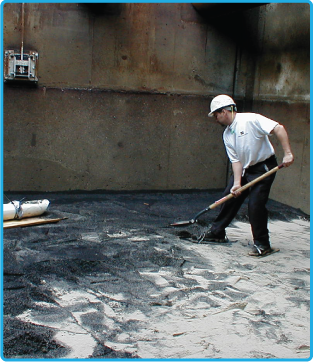1. What’s the difference between granular activated
carbon and anthracite?
Anthracite filter media is employed in the filtration process to remove particulate matter that has already been precipitated out of solution and is sometimes chemically treated to improve its filterability. It doesn’t function very well at the molecular level because its pores are very small, much smaller than most of the molecules that must normally be removed.
GAC (granular activated carbon) is made from agglomerations of PAC (powdered activated carbon) particles. PAC is produced by driving out volatiles and burning away carbon in order to increase the size of the pores in the carbon particles until they resemble a molecular sponge. Depending upon the pore size, activated carbon can even be processed to be selective, removing certain molecules and leaving others behind. This pore structure causes the removal of molecules by the process of adsorption onto the surface of the carbon particle, followed by diffusion into and absorption in the pores. Precipitation is not necessary in this case. However, backwashing alone won’t remove the matter that’s been absorbed into the pores. It can only be removed by a re-generation process.
Anthracite filter media also removes particulate matter from the flow by adsorption. However, this is only a surface phenomenon. Generally, there’s no diffusion into the pores, and the adsorbed matter (adsorbate) is easily removed by agitation during backwashing.
2. What are the benefits of higher quality anthracite?
Since anthracite occurs in the form of laminates in rock formations, its specific gravity, solubility and hardness are variable and in relation to the impurities found with it. Research has shown that these impurities contribute to friability along the cleavage planes. Experience has shown that coal having the properties listed below is more resistant to size reduction because its density and hardness comes from the number of carbon to carbon bonds, rather than from its inherent rock.
1. Specific gravity 1.6-1.7
2. Acid solubility<2.0%
3. Moh's hardness>/=3.0
4. Volatile content<7.0% (dry basis)
5. Carbon content>80%(dry basis)
Intermixing of sand and coal is also more readily controlled if the anthracite is of a high quality. High quality anthracite is more uniform in specific gravity because there is less rock. Particle size degradation is less prevalent because sand abrasion acts upon a smaller percentage of coal particles, and these particles are more durable because they have less coal/rock cleavage planes.
3. Is anthracite available with a MOH hardness greater than 3.5?
Testing for Moh's hardness is not an exact science. "Standard" materials are not homogeneous, and therefore a sample that scratches the "standard" in one lab may not in another. In addition, the scale's increments are not uniform. Fractional values such as 2.7 or 3.5 must be achieved using statistical methods that differ from lab to lab.
Coal that repetitively scratches a copper penny (approximate Moh's hardness of 3) and exhibits the other characteristics of quality anthracite as stated above, has been repeatedly shown to be more durable and to perform longer than coal of lower Moh hardness.
4. Is there any benefit for the anthracite to have a 1.3 UC
rather than a 1.4 UC?
The term Uniformity Coefficient is misleading in this regard. Uniformity Coefficient is defined as the ratio of the theoretical size that just passes 60% by weight of the material divided by the theoretical size that just passes 10% by weight of the material. This 10% size is called the Effective Size (ES), and can be linked to hydraulic filtering properties in the top of a stratified bed. The UC ratio is an indicator of the difference in size between the largest and smallest particles of a particular material like sand, or anthracite used in a filter bed.
In a mono-media bed, stratification is not desired, and the effect of UC is insignificant if air wash is used, the bed is kept un-stratified, and the UC remains below 1.6. In order to ensure that the bed remains un-stratified, the backwash rate must be kept below the fluidization velocity and terminated relatively rapidly.
During backwashing, dual and multi-media filter beds must exceed the fluidization velocity of each of the constituent materials in order to maintain the desired degree of stratification required to realize the advantages of these types of filters. Theoretically, if the anthracite has a lower UC than the other materials, it will intermix less at the interface because the critical particles will be smaller.
In reality however, it’s not necessarily the UC that determines the extent of intermixing. Far more important is the D90, the theoretical size that just passes 90% of the material by weight. In fact, it’s possible to have less intermixing with anthracite having a 1.4 UC if the size distribution curve is straight, or concave down, rather than concave up, as is normally the case with the 1.3 UC materials.
But even more critical are the effects of material quality and the choices of materials employed. Poor quality anthracite can contain a wide range of individual particle densities, and dominate size with weight, regardless of UC.
5. Is there any benefit for the anthracite to be processed wet
rather than dry?
By nature, wet processing produces a cleaner product. Dust is removed and agglomerations are broken up into their constituent particles before sizing when the wet process is used. The anthracite is processed as it’s used in water. Whatever deleterious fines are present in wet processed anthracite are easily removed by backwash and skimming. In most cases, only one backwash and one skim are necessary, as opposed to the lengthy and repetitive processes required for dry processed anthracite.
In addition, the wet process does not result in a weakening of the particles, which can occur during drying. Anthracite coal is a porous material containing, among other things, trapped gasses (principally methane) and water. When the particles are heated, these gases expand and stress the particles that can crack as these volatiles try to escape.
Unlike dry processed anthracite, wet processed anthracite can normally be backwashed immediately after it’s installed. There are precautions of course. However, there is no need to soak wet processed anthracite because its pores are already filled with water and are not hydrophobic. Dry anthracite is hydrophobic and must be soaked for up to 24 hours or more before backwashing can safely be accomplished.
6. What determines whether you should use anthracite
or sand in a mono-media filter?
Mono-media filters can be broken down into two basic types: slow sand and rapid sand filters. Slow sand filters generally operate in the neighborhood of .2 gpm/ft2 (.3 m/hr) and are not backwashed. Therefore, there’s probably no advantage to using anthracite in them.
Rapid filters and high rate filters operate in the neighborhood of from 2 to 5 gpm/ft2 (3 to 7.6 m/hr). Depending upon their purpose, there can be advantages to utilizing anthracite. Although the initial cost might be higher, overall costs are generally lower due to longer filter runs and lower operating costs.
Studies have shown that crushed, angular materials have better filtering characteristics than spherical ones. This would appear to favor the use of anthracite when high quality is the desired result. However, anthracite is fluidized at much lower rates than comparably sized sand and this may pose a media loss problem in some shallow bed situations such as traveling bridge filters. Coarse, deep bed filters generally operate at rates as high as 15 gpm/ft2 (23 m/hr) and require coarse deep beds of highly uniform (i.e. low uniformity coefficient) anthracite in order to realize all of the potential benefits of this design.
Sometimes anthracite is chosen because of its essentially inert qualities, or its affinity for or resistance to certain build-ups. For example, boiler condensate water is generally filtered through beds of anthracite (including support layers) because of the relative absence of silicates in anthracite as opposed to sand. Anthracite has a high affinity for iron, especially when it is coated with potassium permanganate, and is therefore often employed for iron and manganese removal. In lime softening applications, the removed hardness causing deposits are more easily removed from anthracite than they are from sand.
7. Why choose mixed media over dual media?
In certain situations, it’s desirable to employ a third media layer in order to create a greater difference between the smallest size particle in the bottom of the bed and the particle size at the top of the bed. In order to accomplish this, a higher density material is required. Properly sized and proportioned, these mixed media beds are known to result in added protection from breakthrough of certain pathogens like Giardia cysts. The benefits of such beds are mostly realized on cold, low turbidity waters. In this application they are capable of higher flow rates and longer runs with acceptable head loss development characteristics.
Frequently, warmer waters with higher turbidities and higher flow rates result in undesirably high head loss development. In these cases, mixed media is normally not employed. In other cases, such as high turbidity water with minimal driving head available, the benefits of mixed media cannot be realized and thus the cost cannot be justified.
8. How are backwash rates determined?
The determination of appropriate backwash rates is dependent upon the type of bed involved and the type of backwash employed. In general, while dual and mixed media configurations require that the minimum fluidization velocities of each constituent media material be exceeded, this may not be necessary for mono media beds. When air scour is included in the backwash in a mono-media design, it isn’t necessary to achieve fluidization. However, if a lower backwash rate is used, the length of wash must be increased in order to adequately remove the accumulated solids. As a general rule of thumb, it takes between 100 and 150 gallons of water to backwash one square foot of filter depending upon many factors. In addition, the backwash rate must be sufficient to raise and wash out the solids removed by the filtration process. It also must be of long enough duration to do so.

